|
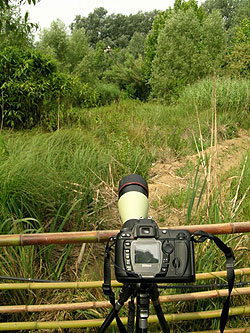
Ready for shooting. The subject is a stork's nest
|
 |
Use of the Fieldscope
The Fieldscope is created exactly for direct sight, therefore for the sight through the human eye.
The subjective and objective quality, perceived through direct sight, is enormously superior to that of any photograph, obtained with any photographic equipment both in sharpness, in contrast and in colour fidelity: between reality and our eye there in only the Fieldscope, without all the variables which can introduced by the camera's film, by the sensor and by the kind of print and by it's final support.
The only accessory, necessary and vital for the most comfortable use of the Fieldscope, is of course a tripod: if the use is purely for direct sight a good tripod is sufficient with moveable head and video in order to move in the field of vision with gentle pannings, which allow both focusing on the subject or to follow it if in motion without abrupt changes.
The Fieldscope and the photograph
Given what we have stated, it is clear that by replacing the eye with a camera we will have photographs from our Fieldscope.
We emphasize that, although the results obtained with the Fieldscope are excellent, even compared to an experiment with a Nikkor 500mm f/4, the most pleasurable and best results are obtained always and in every case by direct sight; if sometimes in astrophotography the help of a camera is indispensable, posing for hours, to show objects so far away they are completely invisible to the naked eye, in terrestrial length vision the photographic shot has to be considered a help not as the main "focus" of the instrument.
We already showed the results obtained in this way in a foregoing experience, in which we connected a Coolpix to a Spottingscope: at that time we connected the mythical 990 to the Spottingscope and we created a "sinister" object but working perfectly.
In the meantime Nikon devoted its self considerably to creating, and has now finally in it's catalogue three original accessories with which to connect, in the best possible way any make of camera, digital or non digital, to the Fieldscope. Here they are in order:
 The Nikon UBK arm: this keeps the Fieldscope and a camera in position simultaneously, usually a digital compact. Thanks to the various micro adjustments of the sliding bracket, it is possible adapt the Fieldscope, to fit any digital compact camera; a quick release, placed on the spherical head of the camera bearer gives immediate fitting. If the Fieldscope is a model with an eye-piece bearer, angled at 45 degrees, it is possible with the arm to observe directly the subject and by a simple rotation immediately positioning the eye-piece in front of the compact camera lens, for the shot to be taken. When we work with a digital compact camera, the Fieldscope eye-piece has of course to be kept engaged in this way the enlargement is obtained, increased by the magnifying of the compact camera zoom gives "extraterrestrial" focals which often border on 10,000mm.
The Nikon UBK arm: this keeps the Fieldscope and a camera in position simultaneously, usually a digital compact. Thanks to the various micro adjustments of the sliding bracket, it is possible adapt the Fieldscope, to fit any digital compact camera; a quick release, placed on the spherical head of the camera bearer gives immediate fitting. If the Fieldscope is a model with an eye-piece bearer, angled at 45 degrees, it is possible with the arm to observe directly the subject and by a simple rotation immediately positioning the eye-piece in front of the compact camera lens, for the shot to be taken. When we work with a digital compact camera, the Fieldscope eye-piece has of course to be kept engaged in this way the enlargement is obtained, increased by the magnifying of the compact camera zoom gives "extraterrestrial" focals which often border on 10,000mm.
 The FSA adapter: the second accessory that Nikon offers is a double ring which incorporates an "o-ring": this is inserted with pressure, directly to the base of the Fieldscope eye-piece: at the top, through interchangeable joint rings, it is possible to link the compact camera through threading on the lens or on to a link if available.
The FSA adapter: the second accessory that Nikon offers is a double ring which incorporates an "o-ring": this is inserted with pressure, directly to the base of the Fieldscope eye-piece: at the top, through interchangeable joint rings, it is possible to link the compact camera through threading on the lens or on to a link if available.
All the Coolpix here can be used, both those in production such as the Coolpix 4500, or those out of production, as the Coolpix 995, 990, 950 and the Coolpix 880, 885,4300,4500,5000: we will have pictures which can be printed in ever increasing enlargements, proportionally to the amount of pixel of our camera. The Coolpix 5000 too, with its adapter for the additional wide and tele lenses can be used; the case of the Coolpix 5400 is different, whose joint ring keeps it too far from the eye-piece, to get a rectangular picture, unless we place the zoom in the tele digital position or we cut the circular picture obtained in post production. Thanks to the enlargement obtained with the eye-piece, in this case too we obtain focals, which don't have a similar result not even with the more powerful tele lens available in the Nikon catalogue.
Of all the systems on offer this is definitely the most nimble: The Coolpix are very light and because they have no mirror like the reflex, they don't have potential problems of vibrations caused when this is turned over before the shot: the shot must however always be made by a cable, MC-EUI type or automatically. The system is then not excessively unbalanced: the Fieldscope tripod attachment is inserted exactly at it's centre and in this way adding the Coolpix doesn't cause problems. If one uses the direct vision Fieldscope one has to rotate the Coolpix monitor to work easily also with a binocular not raised to high from the ground. If one has a Fieldscope with 45 degree angled vision one can work as easily positioning the mirror with the best possible inclination. The FSA adapter incorporates a block system to rotate the attached camera however one requires.
 Nikon FSA-L1. The reflex digital attachment. A new accessory recently introduced on the market, Nikon reflex digital attachment means that as well as working with the reflex system and therefore with the best Nikon sensors available – without using the eyepiece, as with the compacts that invariably if using stratospheric enlargements at the same time the image obtained is often softened, as this must pass first through the eyepiece and then the compact optic.
Nikon FSA-L1. The reflex digital attachment. A new accessory recently introduced on the market, Nikon reflex digital attachment means that as well as working with the reflex system and therefore with the best Nikon sensors available – without using the eyepiece, as with the compacts that invariably if using stratospheric enlargements at the same time the image obtained is often softened, as this must pass first through the eyepiece and then the compact optic.
The FSA-L1 accessory is compatible with all Fieldscope models. According to the model and the diameter of the front lens, it's possible to intervene on the optic system inserted on the attachment positioning some of the optical elements in the most appropriate way with respect to the system which is different for each Fieldscope. A double ring system allows immediate reflex rotation from horizontal to vertical to adapt to the subject. The eyepiece can naturally be taken off, gaining from a nominal focal of 800mm of the Fieldscope a 1,000/1,100mm that thanks to the sensor enlargement effect takes it to a 1,500mm f/13 focal, if a 24 x 36mm format is bought. Adding a focal multiplier one can reach 3000mm without great problems.
The biggest advantage of the FSA-L1 is given by the fact that it can communicate to the camera the Fieldscope f/13 working "diaphragm": this means that with the Nikon digital reflex it's finally possible to work with diaphragm priority, without having to always make exposure tests to check on the monitor and as well as this it's possible to make intentional exposure bracketing. One must naturally work with manual focus acting on Fieldscope focusing, checking then the accuracy with an estimation by eye through the reflex finder and with the manual focus in the digital reflexes.
|
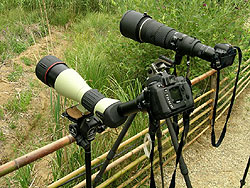
The two monsters: The 82ED Fieldscope
and the 500mm f/4 D multiplied
|
 |
The Strategic Accessory: The Tripod
With a difference to direct vision, where we have spoken about a good tripod, to use the Fieldscope coupled to a reflex digital the worth of the tripod is fundamental. The risk of small movements is high using relatively long shooting times (even 1/125 sec) caused by the fact that the D70, ( we used for this experience) doesn't allow an intentional raising of the mirror before the shot.
An unwritten empirical rule says that the minimum shooting time to use for the focal must correspond to the length of that same focal. Therefore to be sure one should always and only work with 1/1.500, if light conditions permit. It is also true as we will see in the practical tests one can use quicker shoot times bringing the camera to 1600 ISO without any appreciable loss of detail. An excellent tripod and a just as excellent head naturally not moveable but possibly with a system of movements on three axes and micro metrically too. This together with the unavoidable use of the remote (for the D70 is the ML-L3) allow potential micro movements to be contained within acceptable limits. Nobody stops us alternating digital shots with analogical: the camera attachment is the same as that of the optics and also using an analogical camera one can benefit, if the machine allows intentional mirror raising. We can have from digital reflexes in a higher range, like the Nikon D2H, a file with greater pose latitudes with respect to the sensor. Even with the FSA-L1 threads for different rotations inside the Fieldscope and Nikon arm on the opposite face all together with the camera, the risk of small movements is high caused by vibrations made when the mirror is lifted up. This is because whilst the previous systems described using the Coolpix the dead centre of the Fieldscope is always maintained, the weight of the FSA-L1 together with that of the reflex and the distance from the Fieldscope caused by the FSA-L1 (whose 143mm length is given by the number of lenses and groups inside) make the dead centre of the Fieldscope further away and this increases vibration risk. To this one can easily substitute, anchoring both the Fieldscope and the reflex to an arm with a separate double attachment on which to screw on the Fieldscope and reflex; then one must attach the arm to the head of the tripod and if the arm has micro movements also on to the head attachment plate the dead centre is corrected, recalculated and all vibration problems cancelled. As we didn't have this arm when we made this experience we have compensated the risk of small movements bringing the sensitivity of the D70 up to 1600 ISO, without differences in terms of noise with respect to the 200 ISO setting.
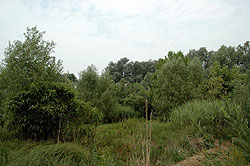 |
Beginning to "move closer" : Nikon D70, 18/70 f/3.5-4.5G on an 18mm lens 400 ISO, 1/500 f/9 |
|
|
|
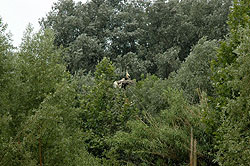 |
70mm lens, f/9, 1/320 |
|
|
|
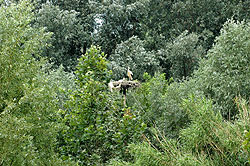 |
100mm lens with a 70/300mm f/4-5.6G, f/9, 1/250 |
|
|
|
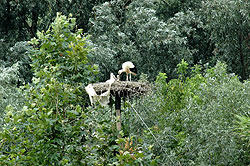 |
210mm lens f/7.1,1/400 |
|
|
|
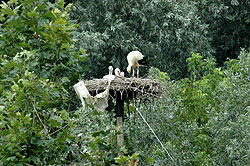 |
and a 300mm lens f/7.1,1/500 |
|
|
|
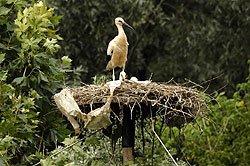 |
With the Nikkor 500mm f/4 D to f/6.3, 1/2500 |
|
|
|
 |
With the Fieldscope to f/13 (fixed opening) 1/640 |
|
|
|
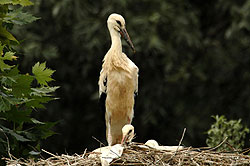 |
The maximum lens reached was 1000mm, multiplying the Nikkor 500mm with an AF-S TC-20E II.f/8, 1/800 |







